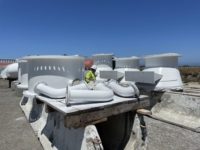The U.S. Environmental Protection Agency recently gave the go-ahead to the city of Palmdale to construct and operate the nation’s first-of-its-kind hybrid power plant.
The EPA’s permit begins the construction planning session for a 570-megawatt natural gas-fired power plant with 50 megawatts of solar energy generation. The city estimates that commercial operations can begin in summer 2013.
According to Jared Blumenfeld, EPA's regional administrator for the Pacific Southwest Region, the permit sets limits for carbon dioxide emissions at 774 lbs per megawatt-hour of power produced, while the clean solar component can generate enough energy each hour to recharge about 750 electric vehicles.
The Palmdale Hybrid Power Plant project combines the use of natural gas-fired technology with that of solar, using mirrors to capture sunlight for conversion into electricity. The solar input will provide around 10% of the peak power generated by the plant during periods of highest energy demand.
The combined-cycle equipment will utilize two natural gas-fired combustion turbine generators, two heat recovery steam generators and one steam turbine generator. The solar thermal equipment will utilize arrays of parabolic collectors to heat a high-temperature working fluid, which will be used to boil water to generate steam.
The EPA said it issued the Prevention of Significant Deterioration (PSD) permit based on the project's ability to meet Best Available Control Technology for greenhouse gases and other pollutants as well the projects demonstrated compliance with all applicable National Ambient Air Quality Standards (NAAQS) for the pollutants regulated under the permit.
The Clean Air Act requires a PSD permit for new and modified major sources of air pollution such as power plants, manufacturing facilities, and other facilities that emit air pollution. PSD permits apply to regulated pollutants that do not exceed the NAAQS in an area. The NAAQS establish maximum pollution concentration levels to protect public health from harmful levels of pollutants such as nitrogen dioxide, ozone, sulfur dioxide, fine particulate, carbon monoxide, and lead.
In January 2011, the PSD program began covering new construction projects that emit at least 100,000 tons of GHG emissions per year, requiring the facility to install the Best Available Control Technology to reduce greenhouse gas emissions, the EPA said.


Post a comment to this article
Report Abusive Comment